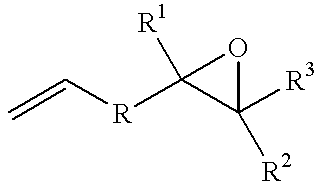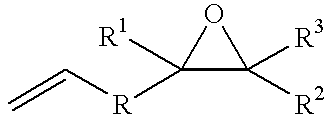Process for producing epoxyorganosilicon compounds
- Summary
- Abstract
- Description
- Claims
- Application Information
AI Technical Summary
Benefits of technology
Problems solved by technology
Method used
Image
Examples
example 2--
At room temperature, 19.18 g of neat VCMX was treated with 0.005 g of Pt(PPh.sub.3).sub.4, 0.040 ml of MeOH, and 0.040 ml of AcOH and warmed. At 90.degree. C., the VCMX solution was reacted with 17.10 g of (MeO).sub.3 SiH. After the (MeO).sub.3 SiH addition was completed, the solution was maintained at 90.degree. C. for one hour. The results are in the table below with other comparative experiments run under similar conditions.
example 14--
At room temperature, 19.23 g of neat VCMX was treated with 0.004 g of Pt(PPh.sub.3).sub.4, 0.090 ml of EtOH, 0.018 ml of AcOH and warmed. At 90.degree. C., the VCMX solution was reacted with 23.14 of (EtO).sub.3 SiH. After the (EtO).sub.3 SiH addition was completed, the solution was maintained at 90.degree. C. for one hour.
example 15--
At room temperature, 20.11 g of neat VCMX was treated with 0.070 ml of RhCl.sub.3 [S(n-Bu).sub.2 ].sub.3, 0.023 ml of AcOH, 0.11 ml of EtOH, and warmed. At 90.degree. C., the VCMX solution was reacted with 24.0 g of (EtO).sub.3 SiH. After the (EtO).sub.3 SiH addition was completed, the solution was maintained at 90.degree. C. for one hour.
EXAMPLES OF THIS INVENTION
General Procedure for the use of Carboxylate Acid Salts in the Pt-catalyzed Hydrosilation Reaction of VCMX and a Silicone Hydride (Si--H):
1.) where Si--H is an organofunctional silane A typical reaction was conducted by treating 1.10-1.30 molar equivalents (vs. Si--H) of VCMX at room temperature with 3000 ppm of an alcohol, 500 ppm of acetic acid (AcOH), a carboxylate acid salt and a catalyst versus total mass of the reaction. Typically, 10 ppm of Pt was sufficient to catalyze the reaction. This solution was warmed. At 90.degree. C., the solution was reacted with 1.00 molar equivalent of Si--H. The solution's temperature w...
PUM
| Property | Measurement | Unit |
|---|---|---|
| Temperature | aaaaa | aaaaa |
| Molar density | aaaaa | aaaaa |
| Molar density | aaaaa | aaaaa |
Abstract
Description
Claims
Application Information
 Login to View More
Login to View More - R&D
- Intellectual Property
- Life Sciences
- Materials
- Tech Scout
- Unparalleled Data Quality
- Higher Quality Content
- 60% Fewer Hallucinations
Browse by: Latest US Patents, China's latest patents, Technical Efficacy Thesaurus, Application Domain, Technology Topic, Popular Technical Reports.
© 2025 PatSnap. All rights reserved.Legal|Privacy policy|Modern Slavery Act Transparency Statement|Sitemap|About US| Contact US: help@patsnap.com


